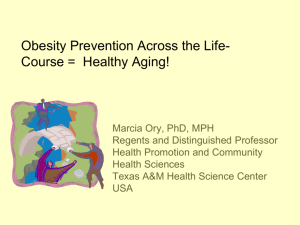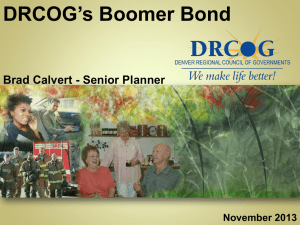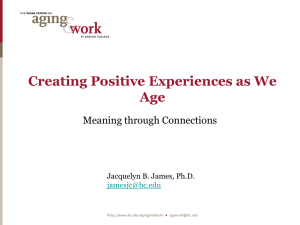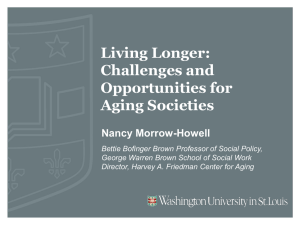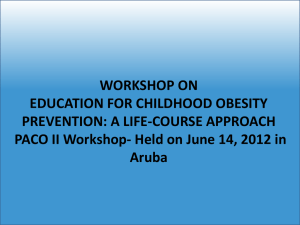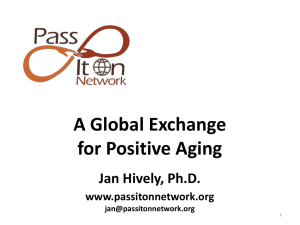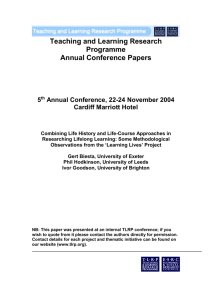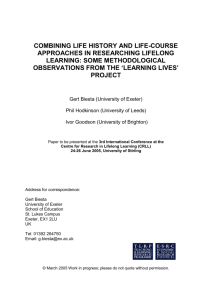Life-course Perspectives for Health Promotion and Obesity
advertisement
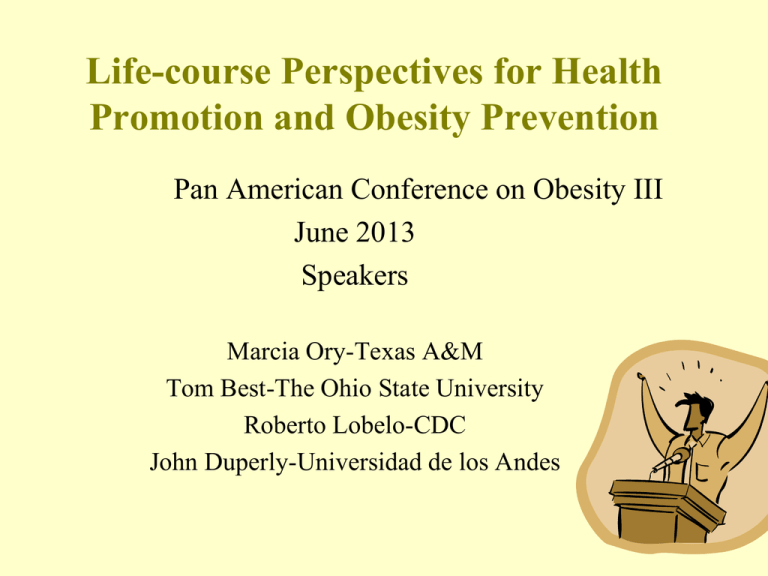
Life-course Perspectives for Health Promotion and Obesity Prevention Pan American Conference on Obesity III June 2013 Speakers Marcia Ory-Texas A&M Tom Best-The Ohio State University Roberto Lobelo-CDC John Duperly-Universidad de los Andes Life-course Perspectives for Health Promotion and Obesity Prevention Workshop Goals and Structure • Introduce the life-course perspective –why we are connecting children and older adults in obesity prevention • Describe the prevalence, risk factors and consequences of childhood obesity and identify intervention strategies for childhood obesity prevention • Identify aging facts and stereotypes, key determinants of healthy aging, strategies for promoting healthy aging; and the role of physical activity in healthy living Life-course Perspectives for Health Promotion and Obesity Prevention Goals and structure, cont • Solicit international perspectives from the audience on what works/doesn’t work in obesity prevention across the life-course • Discuss cross cutting issues in risk factors and solutions and roles of different key stakeholders in formulating solutions; • Mobilize action by having each participant identify two concrete actions for preventing childhood obesity and promoting healthy aging. Welcome and Introductions • What are your affiliations? Professional backgrounds? • What responsibility for obesity prevention? • Do you work with children, older adults, or all populations • What do you hope to get out of today’s workshop? Life-Course Perspectives • Aging is from birth to death • The past shapes the present and future too – Social conditions experienced in early life influence life choices and opportunities – Health behaviors adopted in childhood influence later life – Health in childhood influences health in later life • It’s never to soon to adopt healthy behaviors and never to late Life-Course Themes • Each life transition presents a unique opportunity for interventions to inform policy and practice that can improve health and quality of life • Interventions can be focused on particular stages or on the entire life-course • Chronic diseases likely result from the complex interplay of critical and sensitive period, and trajectory and accumulation processes Life-Course Perspective – Epidemiological Approach • Provides a way to conceptualize how underlying socioenvironmental determinants of health, experienced at different life course stages, can differentially influence the development of chronic diseases • Life course epidemiology examines a range of potential processes through which exposures acting at different stages of life can, singly or in combination, influence disease risk • The importance of timing is illustrated by knowledge that the particular stage of life when an exposure occurs can be important in understanding its later effects Case Scenarios—How typical is Each ? What are the Causes and Solutions • A child is normal weight in primary school and remains normal weight throughout life • A child is obese in primary school and remains obese • A child is normal weight in primary school but becomes obese as an older adult • A child is obese in primary school but becomes normal weight in mid and later life Hold for Childhood Obesity Slides Obesity Prevention Across the LifeCourse = Healthy Aging! Marcia Ory, PhD, MPH Regents and Distinguished Professor Health Promotion and Community Health Sciences Texas A&M Health Science Center USA Questions for Reflection • What does aging mean to you? • At what age does someone become “old”? • What can you do to age more successfully? • How can you help others age more successfully? Behavioral & Social Principles of Aging • Aging as a life-course process • Heterogeneity of the older population • Aging and the social context • Aging as malleable • Potential for intervention How Long Will The Average American Live? A person born today will live almost 78 years (vs 75.28 ys in Aruba) A person who is 65 will live an average of 18.5 longer A woman who is 85 will live an average of 6.8 years longer A person 100 years will live an average of 2.3 years longer Going Beyond Ageist Stereotypes Ageist stereotypes are still part of cultural landscape Ageist stereotypes are health hazards Age and functional status must be considered in designing and evaluating health promotion programs We need to continually confront ageism Ageism is Universal Experience with Ageism Someone assumed I could not understand because of my age Someone told me “you’re too old for that” I was treated with less dignity and respect because of my age A doctor or nurse assumed my ailments were caused by my age Age-Biases in Health Care • Older adults get less aggressive treatments • Older adults not seen as “candidates” for health promotion programs • Older adults often excluded from health studies Old people are sick and frail Old people are set in their ways It’s too late to see gains Physical activity is harmful to older people Keys to Healthy Aging* Positive attitude about aging Keep mind active Be physically active Eat healthy Stay socially engaged Manage stress Live in Healthy Communities *Based on years of behavioral and social research Active Living is Seen as Essential to Good Health The Community Guide: Physical Activity • Campaigns and Informational Approaches • Behavioral and Social Approaches • Environmental and Policy Approaches http://www.thecommunityguide.org/pa/index.html • Staying active — walking, wheeling, and getting moderate regular exercise — helps with both our physical and mental well-being • Staying connected with friends, family, and community is critical to remaining healthy, vital, and active, and is easier if our neighborhood is designed to support interactions. • Staying engaged also benefits the community at large. www.epa.gov/aging/bhc/guide/index.html USA National Blueprint: Increasing Physical Activity Among Adults Aged 50 and Older National Blueprint Increasing Physical Activity Among Adults Age 50 and Older Participating Organizations 50 National Organizations including… • The National Institute on Aging • Centers for Disease Control and Prevention • AARP • National Council on Aging • American College of Sports Medicine • American Geriatrics Society • Administration on Aging 1st Message – The Population is Aging • • • • 2000 - 35 million 65+ yrs. 2011- 41.4 million By 2030, 70 million over 65 yrs. Every day 10,000 Americans turn 60 • Aging is a world wide phenomenon 2nd Message – Chronic Conditions • Over 90% of adults 65 or older have at least one chronic health condition • 73% of older adults have multiple comorbidities • 21% of over 65 have chronic disabilities 3rd Message – Prevention • Preventative •Primary Prevention •Secondary Prevention •Rehabilitative •Acute conditions •Chronic disease •Palliative •Quality of Life 4th Message - Physical Inactivity • 38% of USA population age 55 and older is sedentary • 50% of women age 75 and older engage in no physical activity • Fewer than 50% of older adults ever receive a suggestion to exercise from their physicians 2002- 2012: Strategies to Increase Physical Activity CROSS-CUTTING RESEARCH MARKETING HOME/ COMMUNITY PUBLIC POLICY MEDICAL SYSTEMS Strategies – Cross-Cutting • Develop National Clearinghouse (AFL-NPO) • Public Information Campaign (AARP) • Training Standards (ACSM) Cross-Cutting Strategy 2 Develop a populationsegmented mass-marketing campaign to increase knowledge and awareness levels related to physical activity and fitness among the 50+ population. (AARP) Go4Life-an exercise and physical activity campaign is designed to help you fit exercise and physical activity into your daily life (NIH) www.nia.nih.gov/Go4Life Strategies – Home and Community • Identify community resources (ACSM) • Encourage nontraditional partnerships (NBO) • Identify models of best practice (NCOA) Strategies – Medical Systems • Develop physical activity toolkit (AGS) • Develop local referral networks (ACSM) AGS/ACSM/AAFP Theraband • Disseminate guidelines and best practices (CDC & ACSM) Medical Systems Strategy 3 Develop resources for clinicians to use in making personalized physical activity recommendations/ prescriptions for their patients. (American Geriatrics Society) Strategies – Public Policy • Develop Public Policy Agenda (RWJF) • Educate Policymakers (NCPPA & SGMA) • Cost –effectiveness data (CDC) Public Policy Strategy 2 Educate policymakers about the importance of physical activity for the older population. Include information that provides examples of effective policy in this arena. (National Coalition for Promoting Physical Activity) Physical Activity FAQ 1 WHY SHOULD I BE PHYSICALLY ACTIVE? Regular physical activity can help to improve quality of life in old age. Physical activity can help you stay active and engaged with your family and community. It can help you to manage or postpone some of the chronic diseases and conditions many of us have come to expect from old age. Physical Activity FAQ 2 HOW MUCH PHYSICAL ACTIVITY DO I NEED? Ideally, you should aim to do at least 150 minutes of moderate intensity aerobic activity per week as well as two days per week of resistance exercises. However, start by doing what you can, and gradually look for ways to do more. If you have not been active for a while, start out slowly. After several weeks or months, build up your activities—do them longer and more often. Physical Activity FAQ 3 WHAT IS THE BEST EXERCISE FOR OLDER ADULTS? There is no single best exercise that works for all persons. Some can run marathons or compete in triathlons, whereas others may be more comfortable walking, gardening or doing tai chi. The most important thing is to do regardless of your age is to avoid inactivity.. Physical Activity FAQ 4 HOW MANY TIMES A WEEK SHOULD I EXERCISE? Generally it is better to spread physical activity out throughout the week with a goal of being active on at least 3-5 days per week. By choosing activities that you enjoy, that are convenient and affordable, you may be able to find a way to be active on almost all days of the week. Physical Activity FAQ 5 I HAVE NOT EXERCISED FOR MANY YEARS, WHERE SHOULD I START? Forget the old saying “no pain, no gain” – it is simply not true! There are many excellent options for those of us who cannot or do not want to exercise vigorously. Walking is a wonderful way to increase your activity level. Remember - the most important thing is not what you do - rather - it is most important to avoid complete inactivity. Physical Activity FAQ 6 WILL PHYSICAL ACTIVITY HELP TO REDUCE MY RISK FOR SPECIFIC DISEASES AND CONDITIONS? Physical inactivity is a major risk factor for many physical and psychological conditions. Sedentary living is associated with heart disease, obesity, diabetes and many other conditions. Inactivity is also linked to low selfesteem and psychological depression. Regular physical activity can positively influence all of the above conditions. Physical Activity FAQ 7 IS EXERCISE SAFE? Yes! Almost everyone can find a safe and effective exercise program tailored towards his or her health status, physical activity goals, and personal preferences. It is far more risky to your health to be sedentary than it is to begin a program of light-to-moderate intensity physical activity. Physical Activity FAQ 8 AM I TOO OLD TO EXERCISE? No! You are never too old to exercise! Physical activity has been shown to be of benefit for individuals of all ages including persons as old as ninety and one hundred years of age. Many people just like you are active on a daily basis. You can find a physical activity program that you will enjoy, that will make you feel better, and that will increase your quality of life. Physical Activity FAQ 9 DO I NEED SPECIAL CLOTHING AND EQUIPMENT? No! Special clothing and equipment are seldom needed. Safe and effective physical activity can be performed wearing comfortable street shoes and loose fitting everyday clothes. Effective strength training can be achieved with inexpensive equipment such as elastic bands and water filled jugs. . Its Simple! Adults, get at least 30 minutes of physical activity each day. If it is too hard to set aside 30 minutes at one time, break it up into 10 or 15 minute segments.
